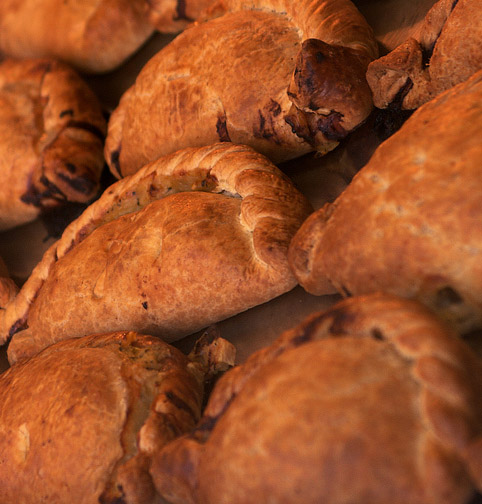Seasonal local food recipe No 84: Cornish pasty

To celebrate the fact that the Cornish Pasty Association (CPA) has received Protected Geographical Indication (PGI) status for its world famous pasty, we thought you might like a traditional Cornish pasty recipe. The difficulty is finding the decisive recipe – there are as many variants as there are pebbles on the beach – but most people agree on the following:
- use a good cut of beef – skirt is the best, chuck is an alternative
- include swede (known as turnip in Cornwall), onion and potato but never carrot
- whether the ingredients are diced or sliced is debatable, but they must go in raw
- seasoning is restricted to salt and plenty of pepper
- the pastry is traditionally shortcrust, made with lard (though a Cornish friend always makes rough puff pastry for hers)
- add a knob of butter or a spoonful of cream for extra richness
The recipe that follows uses grated frozen lard – which adds to the preparation time. Use your normal shortcrust pastry if you prefer.
Serves 4
Preparation: 1 hour +
Cooking: 45-50 minutes
Ingredients
for the pastry:
350g block of lard
450g strong plain flour
pinch of salt
ice cold water to mix
for the filling:
400g beef (skirt or chuck), trimmed and diced
200g onion
200g swede
600g potatoes
salt and pepper
butter/cream
egg wash
Method
Put the lard in its wrapper in the freezer and leave for about an hour until hard. Sift flour and salt into a mixing bowl. Remove the lard from the freezer, peel back the paper, dip into the flour and grate it into the bowl, dipping back into the flour every now and again to make the grating easier. Mix the grated lard evenly into the flour by making sweeping scoops with a palette knife until it resembles heavy breadcrumbs. Stir in 1 tbsp of water at a time until the dough clings together, then form it into a ball. Place the dough in a plastic bag and chill in the fridge for 30 minutes.
Preheat the oven to 200C/gas 6. Keeping separate piles, peel and coarsely chop the onion and peel and dice the swede and potatoes. Roll out the pastry and cut out four circles about the size of a small dinner plate. Sprinkle onion and swede across the centre of the pasty in an oval shape, leaving a 2cm border. Season with salt and pepper. Cover with the meat and then half the potato. Season again and then add the remainder of the potato.
Moisen half the pastry border with a little water, bring up each side of the circle of pastry to enclose the filling, and press together to form a ridge. Crimp with your fingers (see note below).
Grease a flat baking sheet and sprinkle with water. Transfer the pasties to the sheet, prick them in a few places on either side of the seam with a fork and paint all over with egg wash. Bake for 15 minutes, then lower the temperature to 150C/gas 2 and cook for a further 30-40 minutes.
NOTE: How and where to crimp is another question. Some say the crimp should be on top, some on the side. My Cornish friend says she does the crimping on the side then turns the pasty over as she puts it on the baking sheet so that the crimp ends up on top. The CPA’s own recipe shows the crimp on the side.


